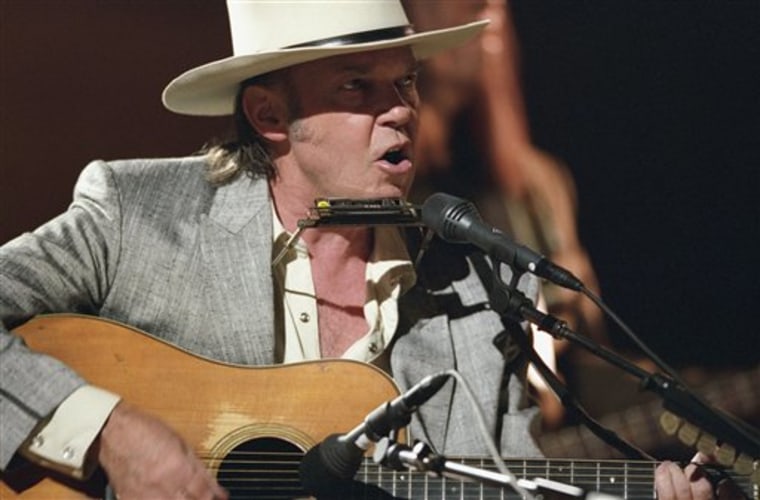Three new concert films — “Neil Young: Heart of Gold,” “Dave Chappelle’s Block Party” and the Beastie Boys’ “Awesome; I ... Shot That!” — take different approaches to what every performance film must reconcile: the audience.
Like a play adapted from the theater to the big screen, concerts often come across less bombastic on film. In interviews with the directors of each of these films, the filmmakers revealed how they dealt with this slippery genre — and those pesky lighter-wielding fans.
Jonathan Demme, the 62-year-old director of “Heart of Gold,” already has one great concert film to his credit: “Stop Making Sense,” the 1984 Talking Heads documentary.
In it, he begins with frontman David Byrne singing alone with only an acoustic guitar and a tape player in front of the unadorned back wall of the stage. As the concert progresses, the stage slowly fills with more musicians and greater spectacle — including Byrne’s famous big suit.
Demme’s approach to “Heart of Gold” is considerably less extravagant.
In it, Young premieres the heartfelt songs of “Prairie Wind,” an album he wrote and recorded in just days before a surgery for a brain aneurysm. Young and Demme decided that the proper setting for the August 2005 concert would be Nashville’s historic Ryman Auditorium.
“If we could film the world premiere where no one had ever heard these songs before, if we could film him delivering these incredibly personal songs for the first time ever in a beautiful place like the Ryman, I just understood that it would be something quite extraordinary,” Demme says.
Not once does the camera pan to the audience, instead it stays locked on Young and his bandmates.
“[Young] kept saying to me, ‘You don’t know what these guys [in the band] look like. Wait ’til you see these faces, man. You’re going to have fun filming these guys because they look like escapees from a [Sam] Peckinpah movie.”’
Demme decided to “keep those cameras steady more than anything on Neil,” he says, rather than jump on “that endless camera movement bandwagon that characterizes 98 percent of what we see.”
“People can go on this emotional journey that awaits them if they surrender to the songs,” says Demme.
Creative talents come togetherFor “Dave Chappelle’s Block Party,” French wizard Michel Gondry casts a wider net.
The director of many lauded music videos and 2004’s “Eternal Sunshine of the Spotless Mind” came on board to film the comedian’s free, daylong concert — as Chappelle describes, “the concert I’ve always wanted to see.”
Held in Brooklyn’s Bedford-Stuyvesant neighborhood, the show featured Kanye West, Common, Mos Def, the Fugees, Dead Prez and others — but the star of “Block Party” is still Chappelle.
His instrument is a simple megaphone. We follow him inviting strangers from his Ohio hometown to the concert, chatting with people in the crowd and rehearsing his between-set routine.
“I think it was interesting not to lie about it and see that it’s actually their work to entertain people and they have their own way to do it,” Gondry says.
As a 42-year-old Frenchman who lives in New York, Gondry would seem an unlikely choice to direct a hip-hop movie, but he says they shared similarities.
“In terms of creation and creativity, I think I can bring something to the audience,” he says. “And when I see the process of creation from one idea to execution, I really like to show that because it [has] only inspired me.”
For the eight-hour concert, Gondry instructed his nine camera crews not to necessarily always focus on the stage, but to shoot whatever was “the center of attention” in their area.
The concert — interwoven with the narratives of Chappelle, several audience members and the musicians — adds up to a documentary beyond the normal conventions of a concert film. It’s more about modern black culture — or as Dead Prez raps in the film, “it’s bigger than hip-hop.”
Audience as directorIf Gondry turns his cameras on the audience, in “Awesome” Adam Yauch hands them right over.
Yauch, known as MCA as a Beastie Boy and Nathanial Hornblower as a filmmaker, wanted to shoot a concert matching the ruggedness of a bootleg, but with more than one perspective and better sound quality.
So on Oct. 9, 2004 at Madison Square Garden in New York, the Beastie Boys handed out cameras to 50 audience members and instructed them to shoot the performance from start to finish from wherever they were seated.
“Awesome...” (the entire title is unfit to print) opens in limited release March 31. “Block Party” and “Heart of Gold” have been in theaters for a few weeks,
Subtitled “an authorized bootleg,” “Awesome” isn’t likely to wow critics, but that was never Yauch’s intention. He got the idea for the movie after seeing footage of the band taken by a fan with his camera phone.
“It just looked really cool, like it was all grainy and low resolution,” Yauch says. “And I just thought it would be interesting to try documenting a whole concert like that.”
The lyric from the Beastie Boys’ song “Sure Shot” summarizes the guiding ethos of the project: “Strictly hand held is the way to go.”
“Right on that lyric, I purposefully cut to one of the spazziest cameras I could find,” Yauch says.
While most concert films try to provide something beyond the fan experience, “Awesome” seeks to simply document it. The most enjoyable moments in “Awesome” are the particularly individual concert-going experiences. One “cameraman” shoots his trip to the bathroom, another films himself (successfully) trying to sneak backstage.
One fan is frequently seen imploring his section to show more enthusiasm for the camera.
“My friend calls him ‘the director,”’ Yauch says. Mimicking the fan, he adds, “I need more energy in my section!”
